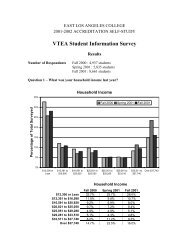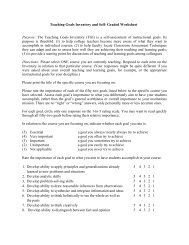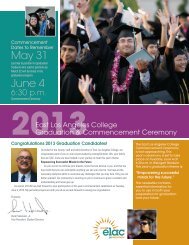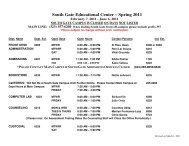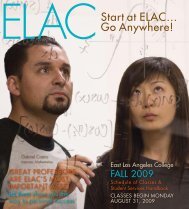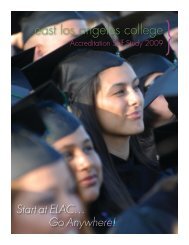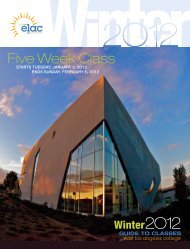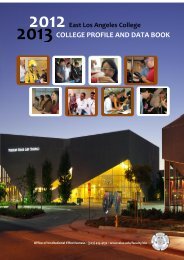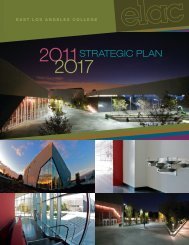ELAC Educational Master Plan - East Los Angeles College
ELAC Educational Master Plan - East Los Angeles College
ELAC Educational Master Plan - East Los Angeles College
Create successful ePaper yourself
Turn your PDF publications into a flip-book with our unique Google optimized e-Paper software.
Academic Senate<br />
<strong>ELAC</strong> Shared Governance Council<br />
Budget<br />
Committee<br />
Strategic <strong>Plan</strong>ning<br />
Committee<br />
<strong>Educational</strong><br />
<strong>Plan</strong>ning<br />
Subcommittee<br />
Facilities <strong>Plan</strong>ning<br />
Subcommittee<br />
Technology<br />
<strong>Plan</strong>ning<br />
Subcommittee<br />
Program Review<br />
and Viabilility<br />
Committee<br />
Distance<br />
Education<br />
Committee<br />
Enrollment<br />
Management<br />
Committee<br />
Matriculation<br />
Advisory<br />
Committee<br />
Off-Site<br />
Committee<br />
Learning<br />
Assessment<br />
Committee<br />
Student Success<br />
Committee<br />
Transfer<br />
Committee<br />
Figure 1: <strong>ELAC</strong> <strong>Plan</strong>ning Structure<br />
All college planning agendas are created through data-driven processes that include national, state, local, and<br />
campus-level data. The Office of Institutional Effectiveness provides comprehensive college data on student<br />
outcomes and college core indicators of success. The college is also guided by the objectives set forth in the<br />
District Strategic <strong>Plan</strong>. Through the use of quantitative and qualitative data, and the direction of the District<br />
Strategic <strong>Plan</strong>, the college regularly reviews its own strategic and planning objectives. In addition, the<br />
Program Review process is used to substantiate the efforts made by departments to improve student learning<br />
and to identify the needs of <strong>ELAC</strong> students and the surrounding community. The Program Review and<br />
Viability Committee reviews and updates the college’s Program Review <strong>Plan</strong> every six years. This plan<br />
includes the schedule for conducting Comprehensive Program Review and Annual Update <strong>Plan</strong>s. The<br />
Comprehensive Program Review Questionnaire focuses on the manner in which each program is supporting<br />
the agenda items listed in the Strategic <strong>Plan</strong>. In addition, the Comprehensive Program Review and Annual<br />
Update <strong>Plan</strong>s utilize Learning Outcomes to assess the degree to which departments and programs are<br />
working to improve the student learning process and creating improvements in student outcomes. Annual<br />
Update <strong>Plan</strong>s are completed in between comprehensive reviews to determine the progress made in<br />
responding to Comprehensive Program Review recommendations and the program or department’s own unit<br />
goals. The Annual Update <strong>Plan</strong>s serve as the basis for resource allocation decisions, such as hiring of new<br />
faculty and staff, purchase of new equipment, and increases or decreases to a unit’s base budget. The<br />
Comprehensive Program Review and Annual Update <strong>Plan</strong>s provide essential data in the development,<br />
implementation, and evaluative planning processes.<br />
All college planning is conducted using evaluation cycles focused on continuous quality improvement for all<br />
instruction, student services, and administrative programs. <strong>ELAC</strong> enters into six-year planning cycles in<br />
which the college progresses through phases of <strong>Plan</strong>ning, Implementation, and Evaluation (PIE). By<br />
incorporating formative evaluations into operational decision-making, <strong>ELAC</strong> ensures that these annual<br />
processes are subject to self-reflective examination on an ongoing basis and that lessons learned contribute to<br />
improvements in these processes. Data-driven measures and formative evaluations contribute to a summative<br />
evaluation of the strategic plan implementation at the end of its six-year cycle. The link between the<br />
formative evaluations and summative evaluation ensures that continuous quality improvement is ongoing and<br />
is the driving force for revisions to the strategic plan. Through this model, the college ensures that all<br />
programs, as well as the college’s governing and decision-making processes, are regularly and thoroughly<br />
evaluated.<br />
4 Page <strong>Educational</strong> <strong>Master</strong> <strong>Plan</strong> 2012





